Phenomenology
of World Religion©
Chapter
10
Doctors of the Church
Doctors of the Church
The
founding Doctors
of the Church were the first to attain
sainthood in a long line of saints of the Holy Roman Catholic Church,
the first organized church in Christian history, established in Rome
after Emperor Constantine
established Christianity as a state-recognized religion. They are
known for the defense of the early Church as well as establishing the
Catholic doctrine. There were eight original Doctors of the Church:
Saint Ambrose, Saint Augustine, Pope Saint Gregory the Great, and
Saint Jerome in the Latin Church; and Saint Athanasius, Saint Basil
the Great, Saint Gregory Nazianzen, and Saint John Chrysostom of the
Eastern Church. In 1568, Saint Thomas Aquinas was added to the list
of the original eight by Pope
Saint Pius V in his promulgation:
Tridentine
Latin Mass.
In
the 20th century, three female saints: Saint
Catherine of Siena, Saint Teresa of
Avila, and Saint Therese of Lisieux were added to the list of
recognized Doctors of the Church bringing the total to 33.
- St. Albertus Magnus (1200-1280), added by Pope Pius XI in 1931. He was a German Dominican friar and a bishop and famous for his knowledge and advocacy of coexistence of science and religion. This opinion would later be supported by Roger Bacon, who was persecuted for such ideas and held prisoner by friars for 14 years; I personally believe he was the greatest German philosopher and theologian of the Medieval period. Albertus was educated at Padua, where he learned and was instructed in Aristotle writings. He became a member of the Dominican Order in 1223 (or 1221) despite protest from his family and studied theology at Bologna. He filled a position as a lecturer at Cologne, Germany, where the Dominicans had a house and taught there for several years. Albertus was the first to comment on the writings of Aristotle, which made it more wider in scope of academic debates. During the course of the study of Aristotle, he began to study the teachings of Muslim academics, most notably Avicenna and Averroes. Worth mentioning is the fact that Albertus did not only study science from books, as others did, but observed and experimented with nature, which some ignorant critics claimed was connections to alchemy and witchcraft. In 1254, Albertus became the provincial of the Dominican Order and fulfilled his duties of office with proficiency. During that time he publicly defended the Dominicans against attacks by secular and regular faculty from the University of Paris. In 1260, Pope Alexander IV made him Bishop of Regensburg, in which he resigned after three years. As a Dominican he refused to ride a horse during his time in office because of his Order believing that walking was more appropriate in the act of humility. In 1270 he preached the eighth Crusade in Austria, being a mediator between conflicting parties in Cologne. He died in Cologne on November 15th, 1280 and his tomb is in the crypt of the Dominican Church of St. Andreas and his relics are at the Cologne Cathedral. Albertus was beatified in 1622 and was canonized and proclaimed a Doctor of the Church in 1931. St. Albert's Feast Day is celebrated on November 15th.
- St. Alphonsus Liguori (1696-1787). Was an Italian Catholic bishop, spiritual writer, scholastic philosopher, and theologian. He founded the Redemptorists and was canonized in 1839 by Pope Gregory XVI. Pope Pius IX proclaimed him a Doctor of the Church in 1871.
- St. Ambrose (340-397), one of the four original Doctors of the Western Church. His real full name was Aurelius Ambrosius and was a bishop of Milan who became one of the most influential ecclesiastical figure of the 4th century. He was born into a Roman Christian family and raised in Tier. His father was the praetorian prefect of Gaul and his mother was an educated intellectual and pious. Ambrose had siblings, Satyrus and Marcellina, who were also venerated saints. Ambrose was the Governor of Aemilia-Liguria in northern Italy until 374 when he became the Bishop of Milan. He was a popular political figure in a day when religion and politics blended together. Ambrose in 374 prevented a crisis turning into something bigger when a church's congregation was squabbling about who should succeed the deceased Auxentius. As bishop he adopted an ascetic lifestyle, providing money to the poor, donating all of his land,, and only leaving enough to provide for his sister, Marcellina, who later became a nun. He committed the care of his family to his brother, Satyrus. During this time, Ambrose wrote a treatise entitled The Goodness of Death. He also, so the legend goes, stopped Arianism in Milan by force as a bishop. He studied theology with Simplician, a presbyter of Rome. Since he knew Greek, he studied the Hebrew Bible and Greek authors like Philo, Origen, Athanasius, and Basil of Caesarea, with whom he communicated with via letters. Ambrose wrote an address to Christian young people warning them against intermarriage with Jews (De Abrahamo, ix. 84, xiv. 451). Under the influence of Ambrose, emperors Gratian, Valentinian II and Theodosius implemented persecution of pagans. Theodosius issued the infamous 391 “Theodosian decree” - a declaration of war against paganism because of Ambrose's insistence. Ambrose died in Milan in 397, two years after Theodosius died and was succeeded as bishop by Simplician. Ambrose's body can still be viewed in the Church of St. Ambrogio in Milan, one of the oldest preserved bodies of historical individuals outside ancient Egypt.

Courtesy of Vatican Library St. Anselm of Canterbury (1033-1109), added by Pope Clement XI in 1720. Saint Anselm was the most outstanding Christian philosopher and theologian of the 11th century; best known for his argument concerning the existence of God in chapter two of the Proslogion, his contribution to philosophical theology, as well as philosophy in general. He was born in a frontier town near Lombardy and little is known about his early life. He left home at the age of 23 and traveled for three years through Burgundy and France, until he arrived at Normandy in 1059. He was interested in the Benedictine abbey at Bec, a famous school. In 1060, Anselm entered the abbey as a novice. He rapidly advanced and was elected to succeed Landranc, the director who had been chosen to be the abbot of Caen in 1063.- St. Athanasius (297-373), one of the original four Doctors of the Eastern Church. Known by several titles: St. Athanasius the Great; St. Athanasius of Alexandria; St. Athanasius the Confessor; and in the Coptic Orthodox Church he is known as St. Athanasius the Apostolic. He was the 20th Bishop of Alexandria i and his position lasted 45 years from 328 to 373; which 17 of those years were spent in five exiles ordered by four different Roman emperors. He is considered to be a Christian theologian, a Church Father, defender against Arianism, and an Egyptian leader of the 4th century. He is most remembered for his zealous role against Arius and Arianism. In 325 Athanasius was the leading individual against the Arians in the First Council of Nicaea. He was a deacon and personal secretary of the 19th Bishop of Alexandria at the time. The Council of Nicaea was convened at the order of Emperor Constantine in 325 to address issues concerning Arian heresy that preached that Christ is a distinct substance from the Father (God). ii Three years later, at the age of 30, he became archbishop of Alexandria and continued to lead the conflict against the Arians for the rest of his life, as well as involving himself with theological and political issues against Emperors Constantine and Constantius, as well as powerful and influential Arian churchmen, led by Arian Bishop Eusebius of Nicomedia and others. His writings were well regarded by Church fathers who followed in the West and the East. He is considered to be the “Father of Orthodoxy” and renowned in the Protestant churches who gave him the title of “Father of the Canon”. Athanasius was venerated as a saint and his feast is May 2nd in Western Christianity, May 15th in the Coptic Orthodox Church, and January 18th in the other Eastern Orthodox churches. He is venerated by the Oriental and Eastern Orthodox, the Roman Catholics, the Lutherans, and the Anglican Communion. His education and studies focused upon Plato as well as Aristotle and was familiar with various philosophical schools of thought, especially Neo-Platonism. In later written works he quoted Homer (Hist. Ar 68, Orat. iv. 29). Athanasius was born into a Christian family and tells in his writing that his aunt taught him principles of the Christian faith, as well as his father and mother. He knew Greek, but didn't know Hebrew and frequently quoted passages from the Septuagint Greek Bible. When he was a student he was influenced by Origen, still remembered in the theological school of Alexandria. St. Athanasius was an Egyptian, born in Alexandria and some believed, because of his fluent Greek, that he was a Greek-born resident of Alexandria. However, in Coptic literature, St. Athanasius is the first patriarch to use Coptic as well as Greek in his texts. His specific theological training was at the Catechetical School of Alexandria.
- St. Augustine of Hippo (354-430), one of the original four Doctors of the Latin Church. Augustine was born in 354 in Thagaste (Algeria) in Roman Africa. His father, Patricius, was a pagan, and his mother, Monica, was Christian. Scholars believe his ancestors included Berbers, Latins and Phoenicians. iii Augustine studied in Carthage to continue his education. He was raised a Christian, but left the church to follow the Manichaean religion. Between 373 and 374 Augustine taught grammar at Thagaste. He converted to Christianity after he read Paul's Epistle to the Romans, and wrote an account of it in his Confessions, which has become a classic theological work. His tomb is located in San Pietro in the beautiful Ciel d'Oro Basilica. His influence upon Protestant reformers was based upon his writings in which he taught that – Adam's guilt as transmitted to his descendants much enfeebles, though does not destroy, the freedom of will. Protestant reformers – Martin Luther and John Calvin affirmed that Original Sin completely destroyed liberty. iv

Courtesy of Vatican Library St. Basil the Great (329-379), one of the original four Doctors of the Eastern Church. Born into a wealthy family of Basil the Elder, a famous rhetor v in Cappadocia, now Kayseri, Turkey. vi He was the Greek Bishop of Caesarea Mazaca in Cappadocia. He was an influential 4th century Christian theologian. Basil supported the Nicene Creed and opposed heresies of the early Christian Church, including the issue concerning Arianism. He was also known for his care of the poor. Greeks remember him as Santa Claus and celebrated his memory on January 1st, which is probably why Greek children traditionally open their Christmas gifts on New Year's Eve. He is considered a saint by both the Eastern and Western Christian communities. At the age of seven he was sent to the monastery of Wearmouth by his family to be educated by Benedict Biscop and later by Ceolfrith.
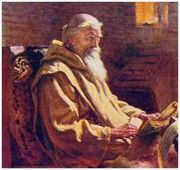
Courtesy of Vatican Library The Venerable Bede (673-735), added by Pope Leo XIII in 1899. Anything that is known about Bede can be found in the last chapter of his Historia Ecclesiastica, a history of the church in England completed in 731. When he was 17 years old, the abbot of Iona Abbey visited Wearmouth and Jarrow. When he was 30 years old he became a priest. In 701 Bede wrote his first works – the De Arte Metrica and De Schematibus et Tropis – both intended as instruction guides to use in the classroom.

Courtesy of Vatican Library St. Bernard of Clairvaux (1090-1153), added by Pope Pius VIII in 1830. French abbot who sought admission into the Cistercian Order after the death of his mother. Three years later he fond a new abbey in an isolated clearing in a glen called Val d'Absinthe. Bernard founded the monastery in 1115 and named it Calire Vallée, which was later changed to Clairvaux. On the death of Pope Honorius II, a schism resulted within the Church. Louis VI of France convened a national council of the French bishops at Étampes in 1130, and Bernard was chosen to judge between the rivaling popes. In 1128, Bernard had assisted at the Council of Troyes, where he outlined the Rule of the Knights Templar. Following the Christian defeat at the Siege of Edessa, the pope commissioned Bernard to preach the Second Crusade. The last years of Bernard's life were saddened by the failure of the crusaders, for which the responsibility had fallen upon him. Bernard died at age 63, after spending 40 years in the cloister. He was the first Cistercian monk placed on the calendar of saints and canonized by Pope Alexander III in 1174.

Courtesy of Vatican Library St. Bonaventure (1217-1274), added by Pope Sixtus V in 1588. His birth name was John of Fidanza, an Italian medieval scholastic theologian and philosopher. He was canonized by Pope Sixtus IV and is known as the “Seraphic Doctor. Many writings believed to be his are now collected under the name Pseudo-Bonaventura.

Courtesy of Vatican Library St. Catherine of Siena (1347-1380), added by Pope Paul VI in 1970. She was a tertiary of the Dominican Order, as well as a Scholastic philosopher and theologian. She also worked to bring the papacy of Gregory XI back to Rome from France, and to establish peace among the Italian city-states. She is one of the two patron saints of Italy, together with St. Francis of Assisi. In her biography there are several miracles attributed to her. One of them was popular in art with paintings such as Mystic Marriage of Saint Catherine.

Courtesy of Vatican Library St. Cyril of Alexandria (376-444), added by Pope Leo XIII in 1883. A Patriarch of Alexandria from 412 to 444 who came to power when the city was still part of the Roman Empire. Cyril was a leading protagonist in the Christological controversies of the 4th and 5th centuries and was the central figure in the First Council of Ephesus in 431, which led to the deposition of Nestorius as Patriarch of Constantinople.

Courtesy of Vatican Library St. Cyril of Jerusalem (315-387), added by Pope Leo XIII in 1883. Theologian of the early Church and venerated as a saint by the Roman Catholic Church, the Eastern Orthodox Church, and the Anglican Communion. It is believed that Cyril came from a family of Christians and he was raised in Caesarea of Palestine, but others say he was born in Jerusalem. Not much is known about his life before he was bishop. St. Cyril was ordained as a deacon by Bishop St. Marcarius of Jerusalem around 335 and a priest eight years later.

Courtesy of Vatican Library St. Ephrem the Syrian (306-373), added by Pope Benedict XV in 1920. he was a prolific Syriac-language hymnographer and theologian of the 4th century and venerated by Christians around the world, especially in the Syriac Orthodox Church as a saint. He wrote many hymns, poems, and sermons as well as prose biblical exegesis.

Courtesy of Vatican Library St. Francis de Sales (1567-1622), added by Pope Pius IX in 1877. He was Bishop of Geneva and a Roman Catholic saint, known for his writings on the topic of spiritual direction and spiritual formation, especially Introduction to the Devout Life, as well as Treatise on the Love of God.
Courtesy of Vatican Library Pope Saint Gregory the Great (540-604), one of the original four Doctors of the Latin Church. Well known for his writings and more prolific than previous popes. During the medieval period he was known as the Father of Christian Worship because of his revision of Roman worship during the time. In Eastern Orthodoxy he is best known for his Dialogues. John Calvin admired Gregory and declared that Gregory was the last good pope. 1 When Gregory was a child, Italy was retaken from the Goths by Justinian I and the war was over by 552. In 554 the Franks invaded and was defeated. The Western Roman Empire had vanished and Gothic kings ruled Italy. After 554 there was peace in Italy and the government now resided in Constantinople instead of Rome; yet Italy was still united as one country and still shared the common language of Latin. A plague starting in 542 swept through the provinces of the empire as well as Italy and devastated one-third of the population. This had a serious affect upon the people, emotionally and spiritually. As thought the plague was not enough, the Totila sacked Rome in 547 and destroyed most of the population the plague had not already taken. Those who were alive and had fled returned to a Rome of empty and ruined streets. Gregory's family owned and resided in a villa suburbana on the Caelian Hill, opposite of the palaces of Roman emperors on Palatine Hill and north of the street that led to the Colosseum, south of Circus Maximus. Gregory was well educated, as people were of his social class and he wrote in Latin, but could not read or write Greek. He knew Latin authors, natural science, history, mathematics, and music and had understood imperial law, which led many scholars to believe he was preparing for a career in public office. Indeed, while his father was alive, Gregory took part in Roman political life and was once a Prefect of the City. Gregory's mother, Silvia, is a saint, which has to be a first among the line of saints. After his father's death, Gregory converted the family estate into a monastery dedicated to the apostle Saint Andrew. While being noted for his mild manner, Gregory was not always forgiving or pleasant, even when he was a monk. For example: A monk was at the brink of death and confessed to stealing three gold pieces. Gregory forced the monk to die friendless and alone, then threw his body and coins on a manure heap to rot with a curse – “Take your money with you to perdition”.

Courtesy of Vatican Library St. Gregory Nazianzen (330-368), one of the original four Doctors of the Eastern Church. Gregory the Theologian was a 4th century Archbishop of Constantinople. He was trained in the classics as orator and philosopher and infused Hellenism into the early Church, thus establishing the foundation of Byzantine theologians and church officials. Gregory was a significant voice in shaping the Trinitarian theology among Greek- and Latin-speaking theologians. Gregory is a saint in both Eastern and Western Christianity and the Roman Catholic Church has counted him to be one of the Doctors of the Church.
- St. Hilary of Poitiers (315-368), added by Pope Pius IX in 1851. In 356, Hilary was summoned by Emperor Constantius II to be reprimanded for persecutions by the Arians in order to crush their opponents. Hilary was banished with Rhodanus of Toulouse to Phrygia, where he spent four years in exile.
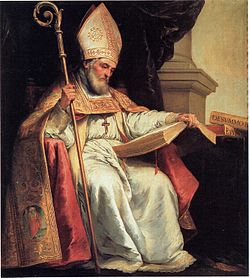
Courtesy of Vatican Library St. Isidore of Seville (560-636), added by Pope Innocent XIII in 1722. Isidore served as Archbishop of Seville for more than 30 years and is considered to be the “last scholar of the ancient world. He lived during a period when classical culture was fading into history and illiteracy began to take its toll, along with violence. Isidore was involved with the conversion of the royal Visigoth, Arians, to Catholicism.
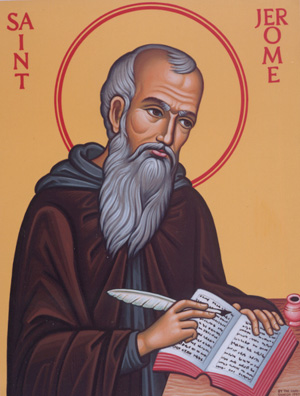
Courtesy of Vatican Library St. Jerome (343-420), one of the four original Doctors of the Latin Church. Jerome was a Roman Christian priest, confessor, theologian and historian who became a Doctor of the Church. He is best known for his translation of the Bible into Latin, called the Vulgate, and his list of writings. The Vulgate is still an important text in Catholicism.

Courtesy of Vatican Library St. John Chrysostom (347-407), one of the four original Doctors of the Eastern Church. An important Early Church Father, Archbishop of Constantinople, eloquent public speaker and an advocate against the abuse of authority by both ecclesiastical and political leaders as written in his Divine Liturgy of St. John Chrysostom. He is best remembered as a preacher, theologian and liturgist. However, he is most noted for his advocacy against Christians participating in Jewish customs and called them “Judaizing Christians” 2 – which led to the Catholic Church developing Christian antisemitism. 3 This doctrine and ideology had ignored the fact that: (1) Jesus was a Jew and practiced Jewish customs, specifically mentioned in the Gospels as the Passover, that later was renamed by the Christian Church as the Last Supper, made famous by Leonardo da Vinci's painting. John's influence upon the church and its teachings can be seen in the current Catechism of the Catholic Church, revised in 1922 that sites in eighteen sections his ideas on the purpose of prayer and the meaning of the Lord's Prayer.
- St. John Damascene (675-749), added by Pope Leo XIII in 1883. John's interests were wide and his contributions many in subjects such as law, theology, philosophy, and music. Some sources 4 state that he had once served as a Chief Administrator to the Muslim Caliph of Damascus. 5 He has been referred to as the Doctor of the Assumption 6 because of his writings on the Assumption of Mary. He composed hymns which are still used today in Eastern Christian monasteries all over the world. He has been considered to be “the last of the Fathers” of the Eastern Orthodox Church and was an advocate in the defense of icons (statuary that represents Christian saints, Jesus, Virgin Mary, etc) – that some factions considered to be Christian idolatry taken from the pagan concept of statues of gods and goddesses; especially after the Church declared that Jesus the Christ was divine and not just a reforming preacher, prophet and messenger of God.
- St. John of the Cross (1542-1591), added by Pope Pius XI in 1926. Not to be confused with John Joseph of the Cross, his birth name was Juan de Yepes Álvarez and a major figure of the Counter Reformation; as well as a Spanish mystic, Catholic saint, Carmelite friar, and priest – born at Fontiveros, Old Castile. Saint John was a reformer of the Carmelite Order and, along with Saint Teresa of Ávila, a founder of the Discalced Carmelites.

Courtesy of Vatican Library St. Lawrence of Brindisi (1559-1619), added by Pope John XXIII in 1959. Born Giulio Cesare Russo, he was a Catholic priest and member of the Order of Friars Minor Capuchin. His family were Venetian merchants in the Kingdom of Naples and he was educated at Saint Mark's College in Venice and joined the Capuchins in Verona as Brother Lawrence. He was appointed Definitor General to Rome for the Capuchins in 1596 and Pope Clement VIII assigned him to convert Jews in the city. Beginning in 1599, Lawrence established Capuchin monasteries in Germany and Austria and worked at bringing Protestants back into the Catholic faith. In 1601, he served as the imperial chaplain for the army of Rudolph II, Holy Roman Emperor, and recruited Philippe Emmanual, Duke of Mercoeur to help fight against the Ottoman Turks. He then led the army during the capture of Székesfehérvár in Hungary from the Ottoman Empire, armed only with a crucifix.

Courtesy of Vatican Library Pope Saint Leo the Great (400-461), added by Pope Benedict XIV in 1754. An Italian aristocrat and the first pope of the Catholic Church to have been called “the Great”. He is best known for having met with Attila the Hun in 452 and persuading him to turn back from his invasion of Italy. He was a dedicated foe of heresy, especially against the Manichean who were fleeing from the Vandals in 439, secretly reorganizing in Rome. He also wrote a treatise against the Priscillianists in 447. At the Second Council of Ephesus in 449, Leo delivered his famous Tome or statement of the faith of the Roman Church in the form of a letter addressed to Archbishop Flavian of Constantinople, which addresses the formulas of western Christology.
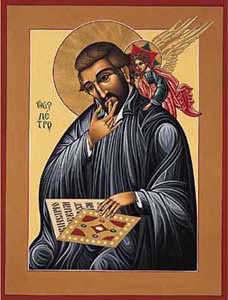
Courtesy of Vatican Library St. Peter Canisius (1521-1597), added by Pope Pius XI in 1925. An important Jesuit Catholic priest who fought against the spread of Protestantism in Germany, Austria, Bohemia, Moravia, and Switzerland. The restoration of the Catholic Church in Germany is attributed to the work of the Society of Jesus, which he was a leader of.

Courtesy of Vatican Library St. Peter Chrysologus (400-450), added by Pope Benedict XIII in 1729. Was Bishop of Ravenna from 433 until his death in 450. In the 8th century, Felix of Ravenna preserved 176 of his homilies.A collection of his homilies, numbering 176, was made by Felix, Bishop of Ravenna (707-17). Some are interpolations, and several other homilies known to be written by the saint are included in other collections under different names.
Courtesy of Vatican Library St. Peter Damian (1007-1072), added by Pope Leo XII in 1828. A monk of reformation in the circle of Pope Gregory VII and a cardinal. The writer Dante placed him in one of the highest circles of Paradiso as a great predecessor of Saint Francis of Assisi. He wrote much upon the reflection of spiritual conditions of Italy and was a vigorous controversialist, his Latin deninciatory epithets became famous.

Courtesy of Vatican Library St. Robert Bellarmine (1542-1621), added by Pope Pius XI in 1931. An Italian Jesuit and a Cardinal of the Catholic Church; he was one of the most important figures in the Counter-Reformation and was canonized in 1930. In 1616, on the orders of Pope Paul V, Cardinal Bellarmine summoned Galileo Galilei and notified him of a forthcoming decree of the Congregation of the Index that condemned Copernican doctrine of the mobility of the Earth and the immobility of the Sun, and ordered him to abandon the idea. 7 In 1633, Galileo would be called again to stand before the Inquisition concerning this matter.
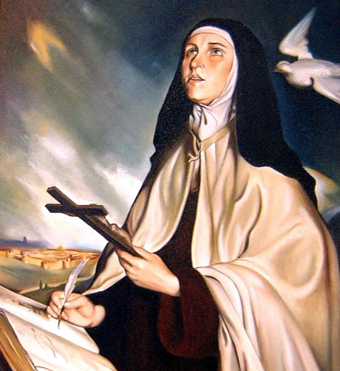
Courtesy of Vatican Library St. Teresa of Avila (1515-1582), added by Pope Paul VI in 1931. Teresa was baptized as Teresa Sánchez de Capeda y Ahumada. She was a prominent Spanish mystic, Roman Catholic saint, Carmelite nun, and writer of the Counter Reformation, and theologian of contemplation of life through mental prayer. She also was a reformer of the Carmelite Order and is considered to be, along with John of the Cross, a founder of the Discalced Carmelites.
- St. Thérèse of Lisieux (1873-1897), added by Pope John Paul II in 1997. She was a French Carmelite nun, known as “The Little Flower of Jesus”. She felt the need for religious life in 1888 at the age of 15, became a nun and joined two of her older sisters in the cloistered Carmelite community of Lisieux, Normandy. After nine years as a Carmelite and holding various offices such as sacristan and assistant to the novice mistress, and eighteen months in Carmel, she died of tuberculosis at the young age of 24. Autobiographical manuscripts were distributed a year after her death to a limited audience at first, but it rapidly spread and became the most popular saint of the 20th century. She was beatified in 1923 and canonized in 1925 – much faster than the great French heroine, Joan of Arc, who died in 1431 and wasn't canonized until 1920. Thérèse was declared co-patron of France with Joan of Arc in 1944.
- St. Thomas Aquinas (1225-1274), added by Pope Saint Pius V in 1568. An Italian Dominican priest of the Catholic Church and influential philosopher and theologian in the tradition of scholasticism. His influence on Western thought is extensive, and modern philosophy was conceived as a reaction against, or in agreement with, his ideas; particularly in the areas of ethics, natural law, metaphysics, and political theory. Thomas is the model teacher in the Catholic Church for those studying for the priesthood.8 His best known works are Summa Theologica and the Summa Contra Gentiles.
-
St. Anthony of Padua –Born as Fernando Martins de Bulhoes, August 15th, 1195; died June 13th, 1231, was a Portuguese Catholic priest and friar of the Franciscan Order. He was born in a wealthy family in Lisbon, Portugal, and died in Padua, Italy. He was a forceful preacher and knowledgeable of the Scriptures. He was declared a saint soon after his death and proclaimed a Doctor of the Church in 1946. After being ordained as a priest, Fernando was named guest master, in charge of hospitality for the abbey in 1219. During that time he came in contact with five Franciscan friars who were on their way to Morocco to preach the Gospel to the Muslims there. Fernando was attracted to the simple lifestyle of the friars. In February of 1220, the five friars received news that they had been martyred in Morocco, the first to be killed in the new order. Seeing their bodies as they were returned to Assisi, Fernando was inspired by the bravery of these men and wished for martyrdom; so he obtained permission from church authorities to leave the Augustinian Canons to join the Franciscan Order. He joined the small hermitage in Olivais and adopted the name Anthony, after Saint Anthony the Great. He then traveled to Morocco to fulfill his new mission. Illness prevented his journey, so he decided to proceed to Italy where the headquarters of his order was located. On the voyage there his ship was grounded on the coast of Sicily due to a storm and he landed at Messina. From Sicily he made his way to Tuscany where he was assigned to a convent of the order, where he didn't do well because of his sickly appearance. Out of compassion, the order reassigned him to the rural hospice of San Paolo near Forli, Romagna, due to his poor health. There he lived as a hermit and worked in the kitchen, spending as much time as possible in private prayer and study. One day on the occasion of an ordination, there were visiting Dominican friars and there was confusion as to who would preach. The Franciscans assumed one of the Dominicans would stand before the pulpit, for they were famous for great speech making; however, they came unprepared. Since Anthony was most qualified as a homilist, the order asked if he would speak whatever the Holy Spirit would help him say. Anthony objected, but unanimously insisted he perform the task and the sermon he gave created a deep impression to those attending. Anthony was then commissioned by Brother Gratian to preach the Gospel throughout the area of Lombardy, in northern Italy. He then came to the attention of Francis of Assisi, where he found a kindred spirit of vision to provide teaching to young members of the order who might seek ordination. Francis then put Anthony in charge of studies for the friar and his skills put to good use. Anthony became ill with Edema. In 1231 he went to the woodland retreat at Camposampiero with two other friars. There Anthony lived in a cell built for him under the branches of a walnut tree. He died on the way back to Padua on June 13th, 1231 at the Poor Clare monastery at Arcella at the age of 36. Legends state that children cried in the streets and that all the bells of the churches rang by themselves. Anthony is buried in a chapel in the large basilica built to honor him, where his tongue is preserved for display in a reliquary as homage to his gift of preaching.
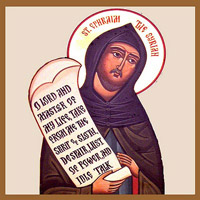
Courtesy of Vatican Library St. Ephrem the Syrian – A Syriac and Syriac-language hymnographer and theologian of the 4th century. He is venerated by Christians throughout the world, and especially in the Syriac Orthodox Church, as a saint. He wrote a large variety of hymns, poems, and sermons in verse, as well as prose biblical exegesis. He has been called the most significant of all the fathers of the Syriac-speaking church tradition.The Doctors of the Church are enumerated into three categories: eminens doctrina, insignis vitae sanctitas, and Ecclesiae declaratio. Translated from the Latin: eminent learning, high degree of sanctity, and proclamation of the Church. The third, as explained by Benedict XIV, as a declaration by the supreme pontiff or by a general council. The decree is issued by the Congregation of Sacred Rites and approved by the pope, usually based upon the saint's writings. Oddly, no martyr has ever been included in the list. Thus, St. Ignatius, St. Irenaeus, and St. Cyprian are not given the title of Doctors of Church, also according to Benedict XIV. As you can see, like government, the Church is filled with bureaucracy and has become complicated in understanding by the general public since its founding. However, with the avenue of the Internet and books upon the subject, much of the confusion is alleviated.
When
St. Thomas Aquinas was declared a Doctor by the Dominican St. Pius V
via the Breviary in 1568, the feasts of the four Latin Doctors was
added to the special mass when a saint is perceived as a Doctor of
the Church. Out of the total of 33 Doctors of the Church, only eight
are of the Eastern Church and 28 are of the Latin Church.
Catholics
pray to saints because Catholics are Christians who believe in life
after death and that relationships with fellow Christians do not end
with death. Catholic prayer to saints is a communion with them.
Patron Saints are often confusing to many. It is a practice that began from
the earliest period of the Church where groups of the faithful
(families, parishes, regions, and countries) chose a particular holy
person who is expected to intercede for them with God.
The
oldest prayers within the Catholic Church is the Litany of theSaints, most commonly recited on All Saints Day, vii
but also used throughout the year, the idea being it brings the
Christian closer to and fully into the Communion of Saints.
The
history and biographies of the saints have passed down as legends,
the church established prayers of the Mass in honor of the famous
dead, saints and martyrs included – from the earliest period of the
foundation of the Christian Church. These legends, called legenda by
the Church that became the history of the saints after the 13th
century. The church did not recognize the legenda as a term of
fiction, despite its common use as a tale of fiction, some may have
been established with factual inserts – embellishment of historical
accounts and biographies.
Today
the word legend has become transformed into the Roman Breviary
that designates the lesson for the day as lectio, the Church
recognizing the legend as a popular story – thus becoming a
fictitious religious tale. This reverts some of its history and
historical figures as objects of Christian mythology, although the
Church declines using this term, back to the conversion of pagans in
ancient Rome. Romans, out of tradition of the Empire, knew that
people are most apt to convert or accept their rule if they provided
religion and culture that was similar to the peoples being conquered
– as a general rule. Thus the early Roman Catholic Church used this
practice as well, despite denial of any similarities of any pagan
rites, doctrines or ideologies. For example, the Church did not know
for sure when Jesus the Christ was born, but had known through the
Apostles (disciples) of the circumstances of his conception and
birth. So the Church established the celebration of the divine birth
during the winter solstice, which had been traditionally a festival
period within pagan culture – especially that found in the region
that Romans named Britannia. Celtic traditions are intermingled
within the celebrations of Christmas, minus the traditional Christmas
Mass and other Catholic specific rites and rituals.
Hagiography
is the focus of theological historians where things like miracles
performed by the saints are based upon the quality of the eyewitness
accounts, et cetera.
Hellenism,
the ancient Greek folktales and religious fables were the forefathers
of the Christian embellishment of heroes; however, in the Hebrew Old
Testament, the Talmud, we find these embellishments as well.
Christian martyrs became heroes, which served as inspiration for
Christians to stand ground against persecution and attempts by pagans
to encourage or force Christians to denounce their faith. This
continued in the tradition of saint worship, who became the
successors of local pagan deities, a key factor in ancient Roman
worship. Therefore, first came the martyrs and then came the saints
in the Christian Church traditions and developed doctrine by the
early councils of the Church established by the founders and the
Doctors of the Church.
The
major literary form of legend remained within the Latin Church, when
the Church was divided between East and West, the former breaking off
during the Great Schism viii
because of the adoption of statues of Christian patriarchs, saints
and martyrs viewed as nothing but replacements for Roman pagan
idolatry. ix
In addition, changing times and local perils also caused the change
in doctrine and Church traditions; such as when the Norsemen
(Vikings) ravaged the coastline and plundered the monasteries and
churches there, murdering monks and priests and violating nuns. The
Crusades brought great change in ideology and Church doctrine. In the
12th century new religious orders established legends of Mary and by
the 13th century this developed into popular usage of the legend
within sermons and even writings for entertainment. The feast of
Corpus Christi was established in 1264 with the establishment of
tales of miracles and the Holy Ghost. It was a period in history
where the common citizen was not afforded the opportunity to an
education, even in the simplest forms of reading and writing – thus
the Church was in control of education and a power behind the state
leadership.
Phenomenology
of Religions, its
chapters, annexes and appendices are protected under US and
international copyright laws - please respect that. Linked/Sourced
excerpts may be used if author is identified and linked. No
commercial reproduction may be produced without the express
permission of the author. Unless otherwise identified,
photographs/images are public domain or the property of Keith Allen
Lehman.
SOURCES
and FURTHER READING:
- Legends of the Saints, H. Günter, 1910; found in The Catholic Encyclopedia; New Advent.
- The Seven Sacraments: Baptism, Confirmation, Holy Communion, Confession, Marriage, Holy Orders, and the Anointing of the Sick; Scott P. Richert.
1F.L.
Cross, ed (1515). "Institutes of the Christian Religion Book
IV". Institutes of the Christian Religion Book IV. New
York: Oxford University Press.
2Walter
Laqueur, The Changing Face of Antisemitism: From Ancient Times To
The Present Day, (Oxford University Press: 2006), p. 48. ISBN
0-19-530429-2.
3John
Chrysostom, Discourses against Judaizing Christians, translated by
Paul W. Harkins. The Fathers of the Church; v. 68 (Washington:
Catholic University of America Press, 1979).
4Suzanne
Conklin Akbari, Idols in the East: European representations of
Islam and the Orient, 1100-1450, Cornell University Press, 2009
p.204
5David
Richard Thomas, Syrian Christians under Islam: the first thousand
years, Brill 2001 p.19.
6Christopher
Rengers The 33 Doctors Of The Church Tan Books &
Publishers, 200, ISBN
0895554402
7
Blackwell (1991,
p.126). The Vatican archives contain an unsigned copy of a
more strongly worded formal injunction purporting to have been
served on Galileo shortly after Bellarmine's admonition, ordering
him "not to hold, teach, or defend" the condemned doctrine
"in any way whatever, either orally or in writing ", and
threatening him with imprisonment if he refused to obey.
However, whether this injunction was ever properly served on Galileo
is a subject of much scholarly disagreement.(Blackwell,
1991, p.127–128) .
iiDurant,
Will. Caesar and Christ. New York: Simon and Schuster. 1972.
iii
Kim Power, "Family, Relatives", Augustine through the
ages: an encyclopedia. Allan D. Fitzgerald (ed.). Grand Rapids:
Wm. B. Eerdmans, 1999, pp. 353 – 354. ISBN
978-0-8028-3843-8 .
iv
Cross, F. L., ed. The Oxford Dictionary of the Christian Church. New
York: Oxford University Press. 2005, article Original Sin .
vii
The day after All Hallows Eve, which most of us know today as
Halloween.
ix
This is not the only reason for the split. The Orthodox Church
shares the belief that God revealed himself in Jesus Christ, the
incarnation of Christ, his crucifixion and resurrection. The main
differences is in the way of Christian life and methods of worship.
Today there are 200 million people who follow the Orthodox Church.
Their culture are elements of Greek, Middle-Eastern, Russian, and
Slavic. While the Byzantine Empire fell, the Orthodox Church did
not. Within the Orthodox Church, it is divided between Eastern and
Oriental due to theological differences. The Eastern Orthodox Church
is the Patriarch of Constantinople, today being Istanbul. An
Orthodox Church was established in America in 1970, while the first
four Orthodox Churches were established in ancient history in
Antioch, Jerusalem, Constantinople, and Alexandria. Later, Churches
were established in Russia, Serbia, Romania, Bulgaria, Georgia,
Cyprus (434), Poland, Albania, Greece, and Czech/Slovak regions.

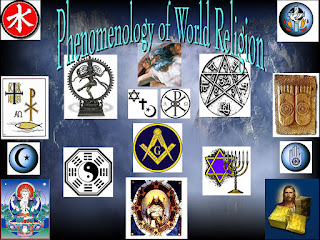


No comments:
Post a Comment